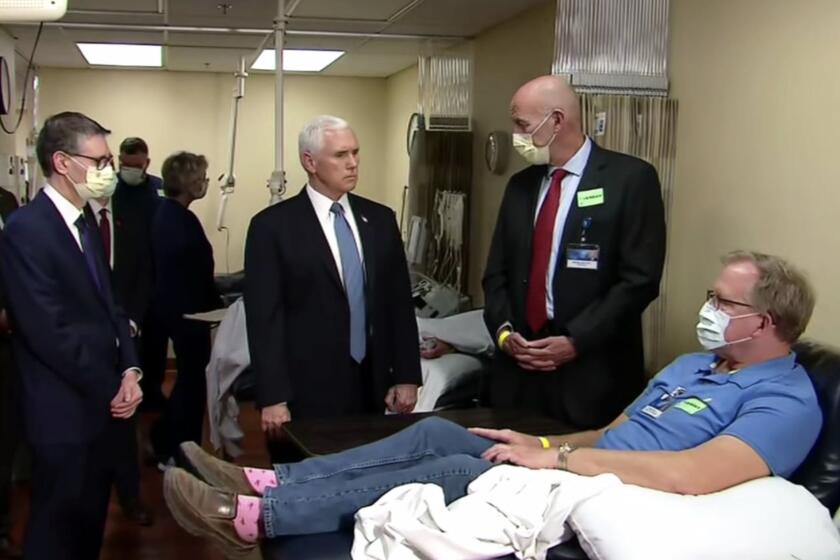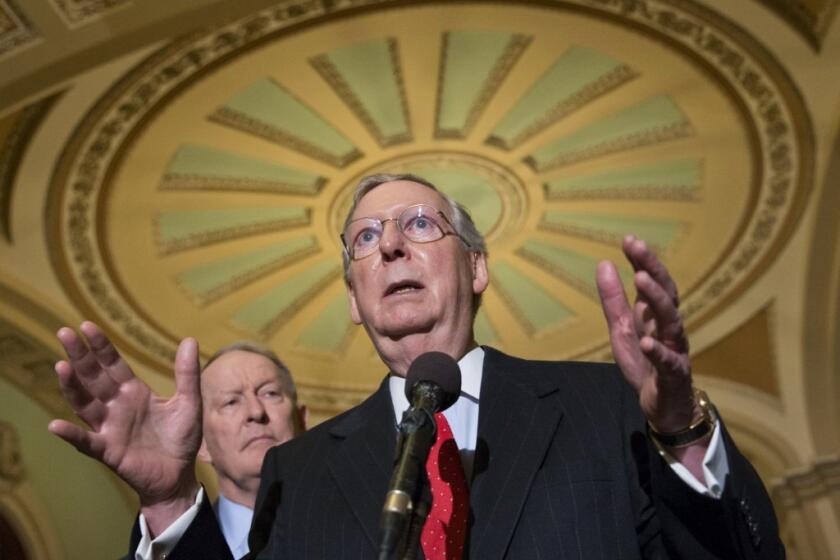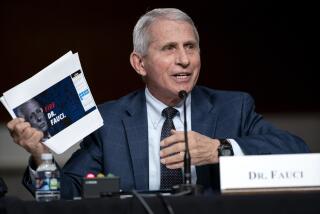Column: How Cedars-Sinai got sucked into the battle over Trump’s claim of a COVID-19 treatment
- Share via
The headline assertion made by President Trump at his April 23 coronavirus press briefing was about injecting disinfectants to kill the virus, a statement that prompted public health authorities and disinfectant makers to warn against doing so.
But Trump talked about a second potential treatment at that briefing — bringing a “very powerful light” inside the body to kill the virus. “The whole concept of the light, the way it kills it in one minute, that’s — that’s pretty powerful,” he said.
Although it was less noticed than Trump’s disinfectant reverie at the time, his tossed-off reference to bombarding the virus with light inside the body has mushroomed into a political cause-celebre. Accusations are flying about that information about the potential treatment has been suppressed on social media simply because it was mentioned by Trump.
The whole concept of the light, the way it kills it in one minute, that’s — that’s pretty powerful.
— President Trump gets the ball rolling on UV light as a COVID treatment
At the controversy’s center is a money-losing Colorado biotech company, Aytu BioScience, which is promoting the light technology as “a potential first-in-class COVID-19 treatment.” Aytu, however, is hanging the credibility of the approach on the respected medical institution where it was developed: Cedars-Sinai Medical Center of Los Angeles, one of the nation’s most respected nonprofit hospitals.
Yet Cedars doesn’t entirely see things the same way. In one of its few public statements about the technology, Cedars pointed out that it’s in “the pre-clinical stages” and “has not been tested or used on patients.”
The institution refuses to make public laboratory data it says might validate claims that the technology would act against the coronavirus, stating that a paper with the data is still under consideration by more than one peer-reviewed scientific journal.
Waiting until the paper is published “reflects the common process used by academic medical centers and other research institutions to advance their science,” Cedars spokesman Duke Helfand told me.
That hasn’t slowed down Aytu, which has promoted the technology on Fox Business and says it’s under political attack by critics of Trump, simply because he mentioned it in public.
At issue is a device Aytu calls the Healight, a flexible catheter equipped with LEDs emitting UVA rays. The goal is to thread the catheter into the trachea of the sickest COVID-19 patients — those undergoing oxygen ventilation — and bombard infected cells with the ostensibly virus-killing light beams. But no evidence that this will work in the human body, or even on viruses at all, has been made public.
The technology was developed at Cedars’ Medically Associated Science and Technology Program, or MAST. Cedars licensed it to Aytu in a deal disclosed in April.
During a conference call the day after it announced the licensing deal for the Healight, Aytu CEO Josh Disbrow cited the technology’s “demonstrated effectiveness in killing the coronavirus,” and said the company would be applying to the Food and Drug Administration for permission for patient use to “begin immediately.”
Scientists are using the coronavirus to study the contagion of misinformation
It’s true that the Healight may eventually prove to have some therapeutic value in the fight against COVID-19. But it may also turn out that much of the enthusiasm for UV light treatment stems from desperation to find something, anything with scientific plausibility, regardless of what data may support.
If the latter, then Cedars-Sinai risks having its name associated with the over-promotion of a chimera. That wouldn’t be good for the medical center’s reputation.
Complicating the issue is the politicization of the search for COVID-19 treatments, stemming from Trump’s predilection for talking up scientifically unvalidated therapies, such as antimalarial drugs and the internal consumption of disinfectants.
Indeed, Aytu says that it has become the victim of a partisan backlash aimed at Trump.
It says its efforts to bring the Healight to public attention have been “censored” by the video services YouTube and Vimeo, which took down a video about the device prepared by the company, and by Twitter, which briefly suspended Aytu’s account.
“These days, politics seems to dictate that if one party says, ‘The sky is blue,’ the other party is obligated to reply, ‘No, it’s not, and you’re a terrible human being for thinking that,’” Disbrow lamented in a Wall Street Journal op-ed on April 27. “That leaves no room for science, in which the data speak for themselves, regardless of ideology, and only when they’re ready.”
Mark Pimentel, MAST’s executive director, declined to be interviewed on the record. “Dr. Pimentel and the MAST team are waiting to speak publicly about the findings until their research is published,” Helfand says.
Yet Pimentel was quoted in an Aytu press release as stating, “Our team has shown that administering a specific spectrum of UVA light can eradicate viruses in infected human cells (including coronavirus) and bacteria in the area while preserving healthy cells.”
Ali Rezaie, an associate of Pimentel’s, was also quoted: “Based on our findings we believe this therapeutic approach has the potential to significantly impact the high morbidity and mortality of coronavirus-infected patients and patients infected with other respiratory pathogens.”
VP Mike Pence flouts the Mayo Clinic’s requirement that visitors wear masks
MAST began working on a technology to treat pathogens with ultraviolet light in 2016. For most of that period, it concentrated on applying the concept to gastroinestinal disorders, the specialty of Pimentel and his top associates.
MAST appears to have released only a single set of data about the concept. This was an abstract published in October in the United European Gastroenterology Journal. It discussed the effect of UVA light on eight varieties of bacteria and one fungus in the lab, and also reported on the safety of a light-equipped catheter inserted into the colons of lab mice.
The study didn’t cover viruses in general and certainly not the coronavirus causing COVID-19, which wasn’t known to exist at the time. Its conclusion from laboratory tests was that UVA rays, which are thought to be less damaging to healthy cells than UVC rays, killed digestive system bacteria. The study also concluded that an optical catheter didn’t produce internal injuries in the mice.
Enter Aytu. The Englewood, Colo., company is awash in red ink, having booked a loss of $27 million on revenue of $7.3 million in fiscal 2019, and an operating loss of of $9.7 million on revenue of $4.6 million in the subsequent two quarters ended Dec. 31.
The company, which had been focused on a product lineup that included testosterone supplements, children’s flouride supplements and cough syrup, plainly detected new opportunities in the coronavirus pandemic. In March it sealed a deal to import a Chinese test for COVID-19 antibodies, though the test was not approved by the FDA.
Rightwingers are using the pandemic to attack public workers, again
Aytu announced the licensing deal with Cedars on April 20. Disbrow discussed the deal in a conference call for Wall Street analysts the following day. The company wasn’t shy about touting its connection with Cedars-Sinai, which it mentioned 10 times in the seven paragraphs of the announcement, not including the headline. Disbrow claimed during the conference call that the Healight showed “demonstrated effectiveness” against the coronavirus.
Two days later, Trump mentioned the technology at his press briefing, and the UV light craze was on.
Fearing that “the president’s comments could trigger a backlash against the idea of UV light as a treatment, which might hinder our ability to get the word out,” Disbrow wrote in his op-ed, “we decided to create a YouTube account, upload a video animation we had created, and tweet it out. It received some 50,000 views in 24 hours. Then YouTube took it down.”
He told me by email, “Whether you want to call it censorship or community guidelines, we are all trying our best to get answers and provide solutions. ... I see this as a ‘we’ issue, not us against them.”
Here’s what a hospital chain went through to get a supply of coronavirus masks
A few points about that. One is whether it’s proper for a biotech company to resort to YouTube animations and Twitter tweets to “get the word out” about a medical device supposedly being submitted for FDA review.
Who is supposed to be the audience for these animations? If not FDA examiners, is it stock investors, who have been generally less than enthusiastic about Aytu? (Its shares reached $2.02, near their peak for the year, on April 27, then fell by about 19% to close at $1.64 on Thursday.)
Disbrow’s complaint got picked up by a clutch of right-wing news sources, which used it to flay Trump’s critics. “Firm tests UV light treatment that Trump was mocked for mentioning,” the conservative Washington Times reported.
“Well, the radical Dems and the leftwing know-nothings might want to slow down just a little bit because the fact is, President Trump may be on to something here,” Lou Dobbs remarked on his Fox Business program April 24. “It turns out the idea of ultraviolet light as a therapeutic within the human body is actually being tested.”
Disbrow himself appeared on Fox Business on April 30. “There’s a bevy of information about UV light ... demonstrating efficacy in eradicating viruses like coronavirus,” he told the anchor.
There are grounds for skepticism, however. One doubter is David Gorski, an oncologist at Wayne State University and veteran debunker of pseudoscience. In a lengthy analysis, Gorski called the device “a highly implausible treatment for COVID-19.”
Gorski noted that the Healight was likely to kill healthy cells as well as infected cells in a way that could end up “greatly exacerbating the inflammatory response that has damaged the lungs to the point where the patient needs to be on a ventilator.”
In Aytu’s animations, he added, the catheter was inserted only into the trachea, not the lungs. That prompted him to question whether the light beam could even reach the worst-infected cells deeper in the lungs. Nor do the animations show how the light could reach other parts of the body evidently attacked by the virus, including the kidneys, central nervous system and the bloodstream.
Aytu defended its claims for the Healight in an April 24 tweet, in which it said “peer-reviewed data will be published in days” to validate its assertions about Healight’s potential as a COVID-19 treatment. So far, however, that hasn’t happened.
Cedars-Sinai’s Helfand told me that Pimentel “doesn’t have a date yet” for publication. He said the study containing the data has been submitted to more than one peer-reviewed journal “to ensure it receives a rigorous review.” It’s possible that the published paper will support Pimentel’s and Aytu’s optimism, but it doesn’t sound as though publication should be expected “in days.”
When I asked whether Cedars is concerned that its reputation or name might be harmed by its being linked publicly with Aytu’s optimistic statements about the Healight, Helfand replied simply, “No.”
But maybe it should be.
More to Read
Inside the business of entertainment
The Wide Shot brings you news, analysis and insights on everything from streaming wars to production — and what it all means for the future.
You may occasionally receive promotional content from the Los Angeles Times.














